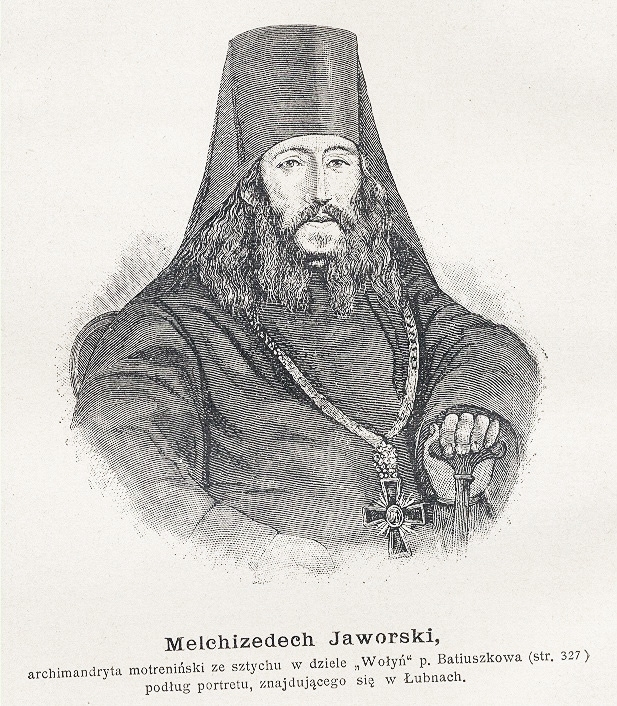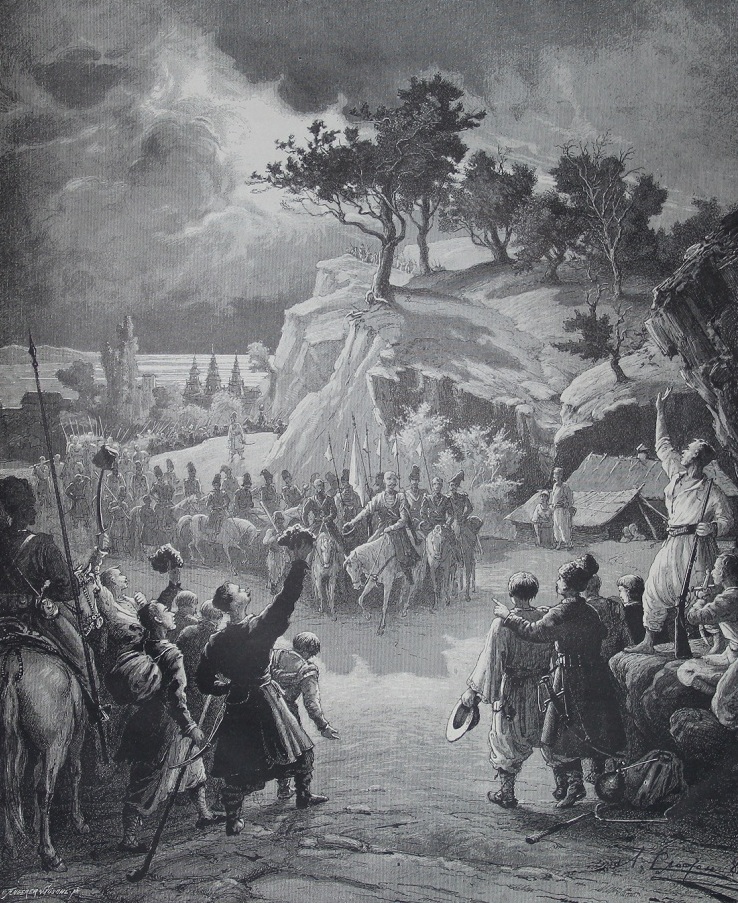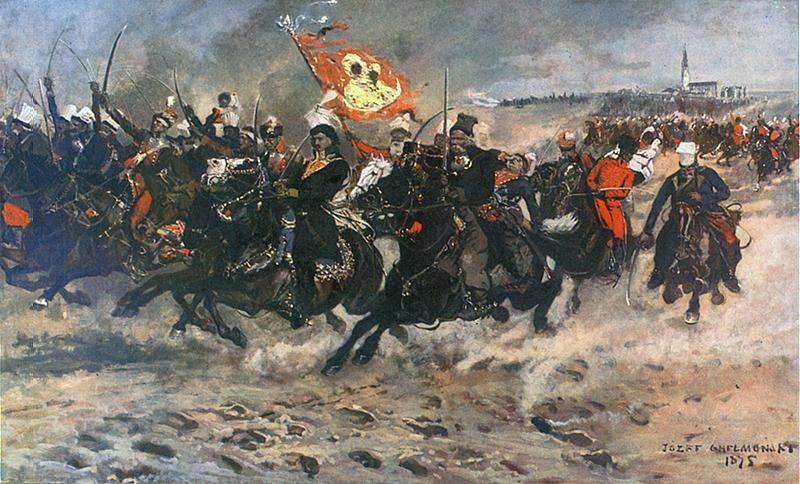|
Koliivshchyna
The Koliivshchyna ( uk, Коліївщина, pl, koliszczyzna) was a major haidamaky rebellion that broke out in Right-bank Ukraine in June 1768, caused by money (Dutch ducats coined in Saint Petersburg) sent by Russia to Ukraine to pay for the locals fighting the Bar Confederation , the dissatisfaction of the peasants with the treatment of Eastern Catholics and Orthodox Christians by the Bar Confederation and the threat of serfdom and the opposition to the nobility and the Poles by the Cossacks and the peasants. The uprising was accompanied by violence against the members and supporters of the Bar Confederation, Poles, Jews and Roman Catholics and especially Uniate clergymen and culminated in the massacre of Uman. The number of victims is estimated from 100,000 to 200,000, because many communities of national minorities (such as Old Believers, Armenians, Moslems and Greeks) completely disappeared in the area of the uprising. Etymology The origin of the word is not certain. Ta ... [...More Info...] [...Related Items...] OR: [Wikipedia] [Google] [Baidu] |
Maksym Zalizniak
Maksym Zalizniak ( uk, Максим Залізняк, Maksym Zaliznyak) (born early 1740s in Medvedivka near Chyhyryn - date and place of death unknown, after 1768) was a Ukrainian Cossack and leader of the Koliivshchyna rebellion. History Zaliznyak was born in a poor peasant family of Orthodox Christians in the Crown land in Polish Right-bank Ukraine about 1740. At a very young age he joined the Zaporozhian Host of Sich in 1753 as an agricultural employee, then a fishery one. By 1767 he had retired both from Sich and his canteen trade and became a lay brother at near Chyhyryn. He learnt that there was a lot of Russian money (false Dutch ducats) in the monastery and in many parts of Ukraine to fund an uprising against Bar confederation. Witnessing Bar confederation oppression of Ukrainian peasants in right-bank Ukraine Zaliznyak decided to divide ducats among rank-and-file Ukrainians, left the monastery and led an uprising of over 1,000 cossacks and of many others througho ... [...More Info...] [...Related Items...] OR: [Wikipedia] [Google] [Baidu] |
Ivan Gonta
Ivan Gonta (; died 1768) was one of the leaders of the Koliivshchyna, an armed rebellion of peasants and Ukrainian Cossacks against Bar confederation in the Polish–Lithuanian Commonwealth. Born in Rożyszki (modern Rozsishky) near Uman' in Bracław Voivodship, Gonta served as a sotnik (captain) of Cossack household militia of Franciszek Salezy Potocki, the Voivode of Kiev, and commanded a small unit in the garrison of Uman since 1757. During the Koliivshchyna he was ordered to fight the approaching haidamaka forces of Maksym Zalizniak. Instead, he and his militia joined the rebels, and the joint forces captured and ravaged the town of Uman on June 21, 1768. In what became known as the Massacre of Uman, thousands of local Polish szlachta, Jews, Uniates and other people were slaughtered. After that, Gonta was proclaimed colonel and commanded the garrison of Uman. When Gonta sent a detachment to spread rebellion into the Ottoman Empire, Catherine the Great, the Empress of Russia ... [...More Info...] [...Related Items...] OR: [Wikipedia] [Google] [Baidu] |
Melkhisedek Znachko-Yavorsky
Melkhisedek (Znachko-Yavorsky) ( uk, Мельхіседек (Значко-Яворський)) was a famous religious figure and Archimandrite of the Kyivan Rus-Ukraine. As a religious leader of the Eastern Orthodox Church in the area, he played a key role during the Cossack-Christian uprising of XVIII century on the banks of river Dnieper called Koliivshchyna. Melkhisedek was born as Matviy around 1716 to the Lubny sotnik Karp Kostysh with a Cossack's nickname Znachko who in 1766 received an official certificate of affiliation with a noble family of Yavorsky. In 1738 Melkhisedek graduated from the Kyiv Academy. Same year he entered the Motronyn Saint Trinity monastery near Chyhyryn (today a nunnery). In 1745 Melkhisedek received monastic vows. In 1753 – 1768 he was a hegumen of the monastery. In 1761 Melkhisedek was placed in charge of all Orthodox monasteries and churches in the right-bank Ukraine by Bishop Hevrasiy Lyntsevsky and was suffragan to the Bishop of Pereyaslav. He ... [...More Info...] [...Related Items...] OR: [Wikipedia] [Google] [Baidu] |
Haidamaky
The haidamakas, also haidamaky or haidamaks (singular ''haidamaka'', ua, Гайдамаки, ''Haidamaky'') were Ukrainian paramilitary outfits composed of commoners (peasants, craftsmen), and impoverished noblemen in the eastern part of the Polish–Lithuanian Commonwealth. It was a reaction to the Commonwealth's actions that were directed to reconstitute its orders on territory of right-bank Ukraine, which was secured following ratification of the Treaty of Perpetual Peace with Muscovy in 1710. Etymology and terminology Etymology The word ''haydamak'' has two related meanings: either 'Ukrainian insurgent against the Poles in the 18th century', or 'brigand'. The role played by haydamaks in the anti-Polish Ukrainian revolts of the 18th-century led by Maksym Zalizniak and Ivan Honta led to the first meaning. The word has been adopted into Ukrainian from the Crimea and the neighbouring region, where it has been used in some Kipchak, Oghuz and Slavic languages. The origin ... [...More Info...] [...Related Items...] OR: [Wikipedia] [Google] [Baidu] |
Haidamaky
The haidamakas, also haidamaky or haidamaks (singular ''haidamaka'', ua, Гайдамаки, ''Haidamaky'') were Ukrainian paramilitary outfits composed of commoners (peasants, craftsmen), and impoverished noblemen in the eastern part of the Polish–Lithuanian Commonwealth. It was a reaction to the Commonwealth's actions that were directed to reconstitute its orders on territory of right-bank Ukraine, which was secured following ratification of the Treaty of Perpetual Peace with Muscovy in 1710. Etymology and terminology Etymology The word ''haydamak'' has two related meanings: either 'Ukrainian insurgent against the Poles in the 18th century', or 'brigand'. The role played by haydamaks in the anti-Polish Ukrainian revolts of the 18th-century led by Maksym Zalizniak and Ivan Honta led to the first meaning. The word has been adopted into Ukrainian from the Crimea and the neighbouring region, where it has been used in some Kipchak, Oghuz and Slavic languages. The origin ... [...More Info...] [...Related Items...] OR: [Wikipedia] [Google] [Baidu] |
Haydamak
The haidamakas, also haidamaky or haidamaks (singular ''haidamaka'', ua, Гайдамаки, ''Haidamaky'') were Ukrainian paramilitary outfits composed of commoners (peasants, craftsmen), and impoverished noblemen in the eastern part of the Polish–Lithuanian Commonwealth. It was a reaction to the Commonwealth's actions that were directed to reconstitute its orders on territory of right-bank Ukraine, which was secured following ratification of the Treaty of Perpetual Peace with Muscovy in 1710. Etymology and terminology Etymology The word ''haydamak'' has two related meanings: either 'Ukrainian insurgent against the Poles in the 18th century', or 'brigand'. The role played by haydamaks in the anti-Polish Ukrainian revolts of the 18th-century led by Maksym Zalizniak and Ivan Honta led to the first meaning. The word has been adopted into Ukrainian from the Crimea and the neighbouring region, where it has been used in some Kipchak, Oghuz and Slavic languages. The origin i ... [...More Info...] [...Related Items...] OR: [Wikipedia] [Google] [Baidu] |
Haydamaky (poem)
Haidamaki ( ua, Гайдамаки) is an epic poem by Taras Shevchenko about the Koliivshchyna led by Maksym Zalizniak and Ivan Gonta. The poem was written in about 1839–1841 and first published in full as a separate book in Saint Petersburg in 1841. It is dedicated to his friend, artist, Vasyl Ivanovych Hryhorovych. See also * Izbornyk * Koliivshchyna (film) * List of Ukrainian-language poets * List of Ukrainian-language writers * Ukrainian literature Ukrainian literature is literature written in the Ukrainian language. Ukrainian literature mostly developed under foreign domination over Ukrainian territories, foreign rule by the Polish–Lithuanian Commonwealth, Poland, the Russian Empire, t ... References External linksTranslation by John Weir Ukrainian literature Taras Shevchenko Ukrainian-language books 1841 poems {{Ukraine-stub ... [...More Info...] [...Related Items...] OR: [Wikipedia] [Google] [Baidu] |
Mikhail Krechetnikov
Michael N. Krechetnikov (russian: Михаил Никитич Кречетников, 1729, Moscow, Russian Empire – 9 May 1793, Medzhybizh, Podolie Vice-Royalty, Russian Empire) was a Russian military commander and General of Infantry (General-in-chief). He was the younger brother of Pyotr Krechetnikov. Life The son of Nikita Krechetnikov, a state councillor, he graduated from the Land Gentry Corps and fought with the rank of second major in the Seven Years' War. During the Russo-Turkish War he distinguished at Kagul, for which he was promoted to Major-General. He then took part in the quelling of a revolt in the Ukraine (Koliyivshchyna) on the orders of Catherine II. From July 1775 he was governor-poruchik of Tver and then from 1776 governor of Kaluga and Tula. In 1790 he was awarded the title of general-anshefa. He fought in the Polish–Russian War of 1792, commanded Russian troops in Lithuania and was appointed Governor-General of that area (then including Belarus, Lithuania ... [...More Info...] [...Related Items...] OR: [Wikipedia] [Google] [Baidu] |
Massacre Of Uman
The Massacre of Humań, or massacre of Uman ( pl, rzeź humańska; uk, "уманська різня" or "взяття Умані") was a 1768 massacre of the Jews, Poles and Ukrainian Uniates by haidamaks. The murders were committed at the town of Uman in the far eastern part of the Polish–Lithuanian Commonwealth. Uman was a well-fortified town that held a large garrison of Bar confederation troops under the command of Rafał Mładanowicz, the governor of Uman who joined Bar Confederation. This fact made Uman one of the primary targets of Koliyivschyna movement, and it is likely that the siege of Uman was planned well in advance probably even by Russian officers. Ivan Gonta, an officer in the private militia of the owner of Uman Count Franciszek Salezy Potocki (made up of Household Cossacks) was accused of connections with haidamaka by some people from the local Jewish community three months before the siege and long before the uprising. However, due to the lack of hard evidence ... [...More Info...] [...Related Items...] OR: [Wikipedia] [Google] [Baidu] |
Jan Klemens Branicki
Count Jan Klemens Branicki (also known as Jan Kazimierz Branicki; 21 September 1689 – 9 October 1771) was a Polish nobleman, magnate and Hetman, Field Crown Hetman of the Polish–Lithuanian Commonwealth between 1735 and 1752, and Great Crown Hetman between 1752 and 1771. One of the wealthiest Polish magnates in the 18th century, owner of 12 towns, 257 villages and 17 palaces. He was the last male representative of the Branicki family. He was a recipient of the Spanish Order of the Golden Fleece. Biography He was the son of the Palatine of Podlaskie Voivodeship Stefan Mikołaj Branicki and Katarzyna Scholastyka Sapieha, the daughter of Hetman Kazimierz Jan Sapieha. Jan had three wives: The first wife was Princess Katarzyna Barbara Radziwiłł, the daughter of Count and Grand Marshal Karol Stanisław Radziwiłł, whom he married on 1 October 1720 in Biała Podlaska. His second wife was Barbara Szembek in 1732; this marriage ended in a divorce. His third and last wife was ... [...More Info...] [...Related Items...] OR: [Wikipedia] [Google] [Baidu] |
Taras Shevchenko
Taras Hryhorovych Shevchenko ( uk, Тарас Григорович Шевченко , pronounced without the middle name; – ), also known as Kobzar Taras, or simply Kobzar (a kobzar is a bard in Ukrainian culture), was a Ukraine, Ukrainian poet, writer, artist, public and political figure, folklore, folklorist and ethnography, ethnographer.Taras Shevchenko in the Great Soviet Encyclopedia, 3rd Edition. 1970-1979 (in English) His literary heritage is regarded to be the foundation of modern Ukrainian literature and, to a large extent, the modern Ukrainian language, though this is different from the language of his poems. He also wrote some works in Russian (nine novellas, a diary, and an autobiography). Shevchenko is also known for his many masterpieces as a painter and an illustrator. [...More Info...] [...Related Items...] OR: [Wikipedia] [Google] [Baidu] |
Bar Confederation
The Bar Confederation ( pl, Konfederacja barska; 1768–1772) was an association of Polish nobles (szlachta) formed at the fortress of Bar in Podolia (now part of Ukraine) in 1768 to defend the internal and external independence of the Polish–Lithuanian Commonwealth against Russian influence and against King Stanislaus II Augustus with Polish reformers, who were attempting to limit the power of the Commonwealth's wealthy magnates. The founders of the Bar Confederation included the magnates Adam Stanisław Krasiński, Bishop of Kamieniec, Karol Stanisław Radziwiłł, Casimir Pulaski, his father and brothers and Michał Krasiński. Its creation led to a civil war and contributed to the First Partition of the Polish–Lithuanian Commonwealth. Maurice Benyovszky was the best known European Bar Confederation volunteer, supported by Roman Catholic France and Austria. Some historians consider the Bar Confederation the first Polish uprising. Background Abroad At the end ... [...More Info...] [...Related Items...] OR: [Wikipedia] [Google] [Baidu] |



